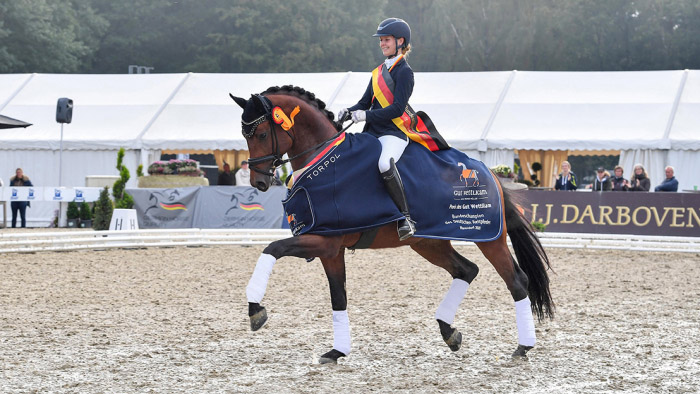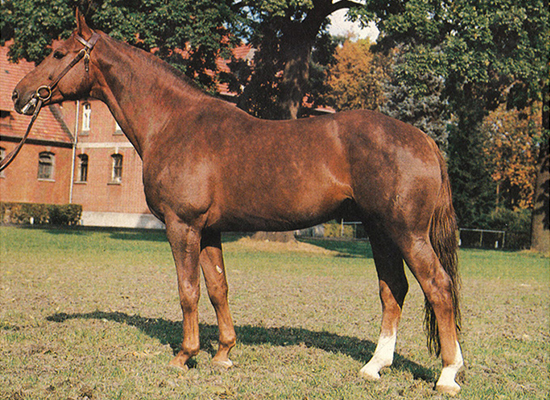
1971- 1988 166 cm Chestnut
Breeder: Werner Thalmann
Now that the W line has virtually disappeared from dressage breeding, it is hard to remember back to when the Weltmeyer boom was in full swing. The imposing chestnut stallion was to be the savior of Hanoverian breeding and the answer to the uppity private stallion just over the border in Oldenburg, Donnerhall.
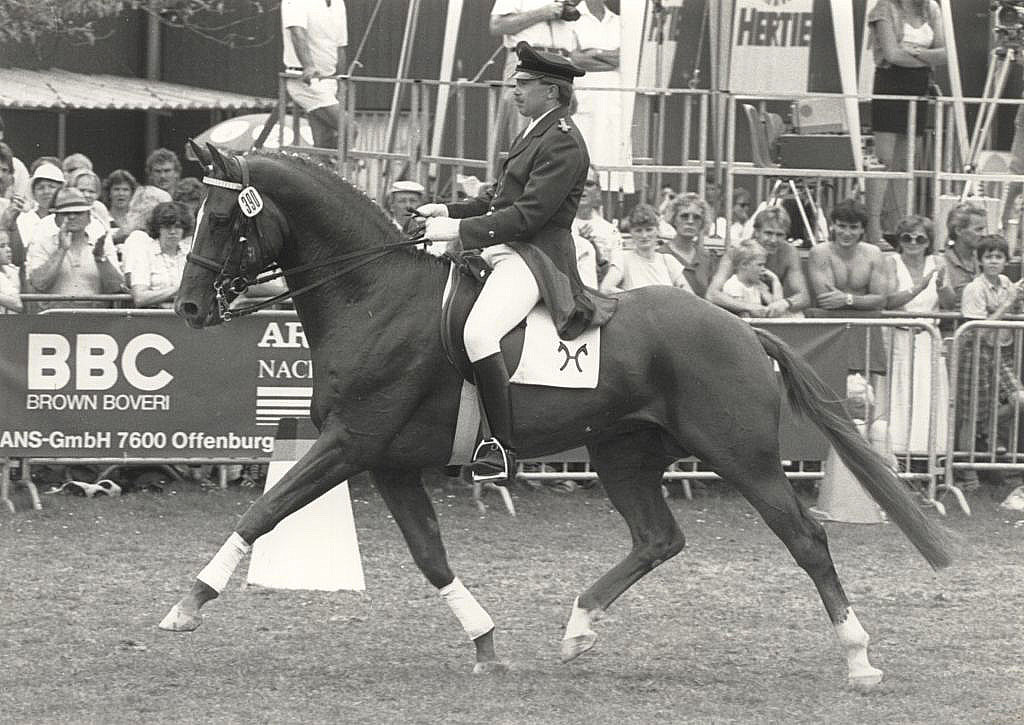
Weltmeyer, Weltmeyer, Weltmeyer
Certainly when I first traveled through Lower Saxony, on the Hanoverian study tour, it was Weltmeyer, Weltmeyer, Weltmeyer, and each year more and more young sons were licensed by the stallion commission.
It all started with one of the first dressage stallions in the breeding district – Woermann.
The first public appearance of the two and a half-year-old Woermann at the Hanoverian licensing in 1973 at Verden signaled a total turnaround in Warmblood breeding. Woermann was the new measuring-stick for type, riding oriented outline and construction, but particularly in movement – his elastic, rhythmic and elevated trot was unseen before.
These impressions were confirmed in the 1973 stallion performance test. As expected, Woermann passed with flying colours, and the final report certifies: ‘energetic temperament, sufficient durability, very good rideability, jumping ability of good average, very good walk, outstanding trot, good canter – a very talented riding horse, most suitable for dressage.’ Which was timely since just about then, the sport of dressage was growing in importance and prestige, and breeders were now looking to breed for that market.
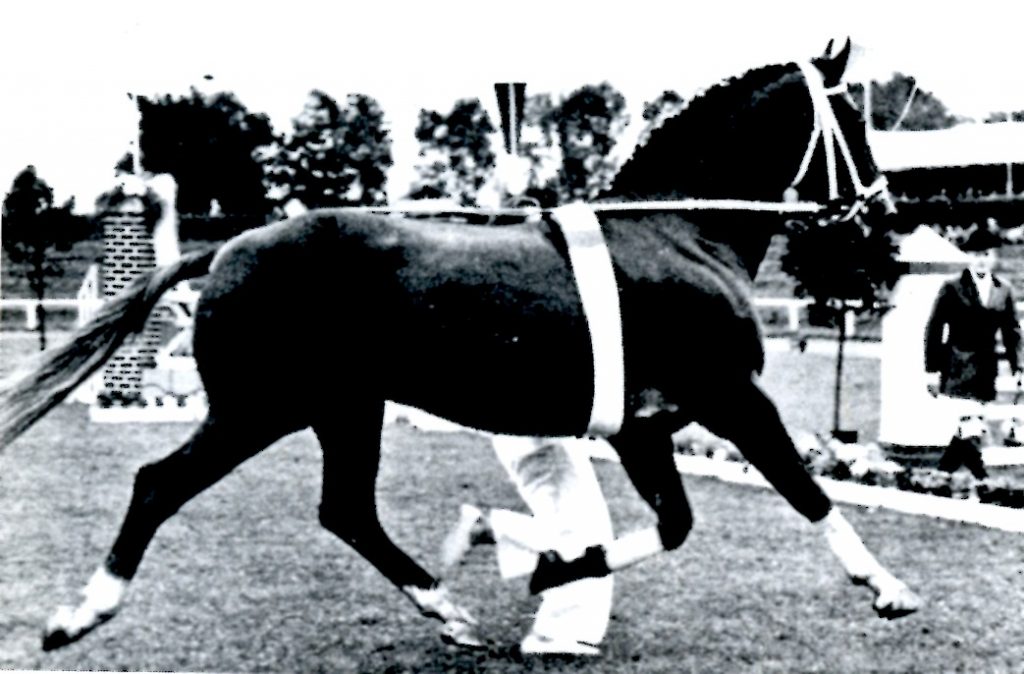
The well-liked Wöhler
Woermann was the last and best son of the well-liked Wöhler (1950-1971). His dam stems from the solid and high-quality broodmare base of the northern Hanoverian breeding area, on the shores of the North Sea, positively influenced by her sire, the Thoroughbred stallion, Marabou xx. Wöhler himself was very much influenced by his maternal sire, the Thoroughbred, Ecco xx.
According to Claus Schridde in the 2000 edition of Berndt Eylers’ Selected Sires of Germany, Wöhler was ‘for many years the quintessence of dressage horses in the breeding region of Hanhover. The liver chestnut covered for a long time in Burlage and thereafter in Alterbruch from 1967 to 1971. He presented the three approved sons, Wohlklang as well as Wunsch I and Wunsch II in his first years. Whilst Wunsch I and Wunsch II, were at best, average sires (the second nevertheless sired Harry Boldt’s Olympic dressage competitor, Woyceck) it would have been desirable for the noble and well-bred Wohlklang to carry on the lineage.’
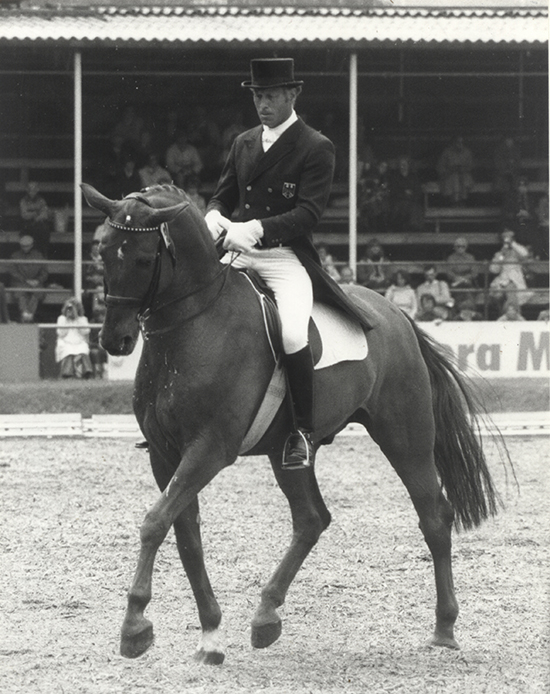
Woyceck and Harry Boldt
‘The stations where he covered (Wittingen and Luhmühlen) however had never really been known as strong producers of stallions, so that Wohlklang was restricted to furnishing high-class dressage horses and showjumpers, quality brood mares and highly remunerated auction horses… The upholder of the Wöhler blood therefore came from another quarter. This was Woermann who resulted from the Altenbruch covering period.’
‘The liver chestnut Woerman derives from a high-class dam line. His dam Mandate is one of the few daughters of the Schelderhan Thoroughbred, Marabou xx. The dam line furthermore brought forth such well-known sires as Ambassadeur (private stallion Oldenburg), Ariston (private stallion Hanover), Boredo (private stallion Westphalia), Dior (Warendorf state stallion), Döbeln (Celle state stallion), Dornheld, Firn, Jupiter, Seemann and Sempach (all Neustadt / Dosse State stallions), Gambler’s Star (private stallion Hanover), Mylord (Marbach state stallion) as well as Partisan and the top sire of showjumpers Sender (both Celle State stallions).’
Once again, I draw on the knowledge of my friend Ludwig Christmann:
“Woerman was a good foal producer and even at that time 80% of the mare owners were looking to produce foals. Most of the breeders were farmers and they did not want to have to rear and train themselves, they wanted to sell foals. And Woerman was a stallion who produced good types, and he and his sons became very popular.”
However there was a feeling that Woermann could produce horses with a slightly difficult temperament, very few of them became top competitors, and it was his most famous son, World Cup, who really played a crucial role in the development of the modern dressage horse.
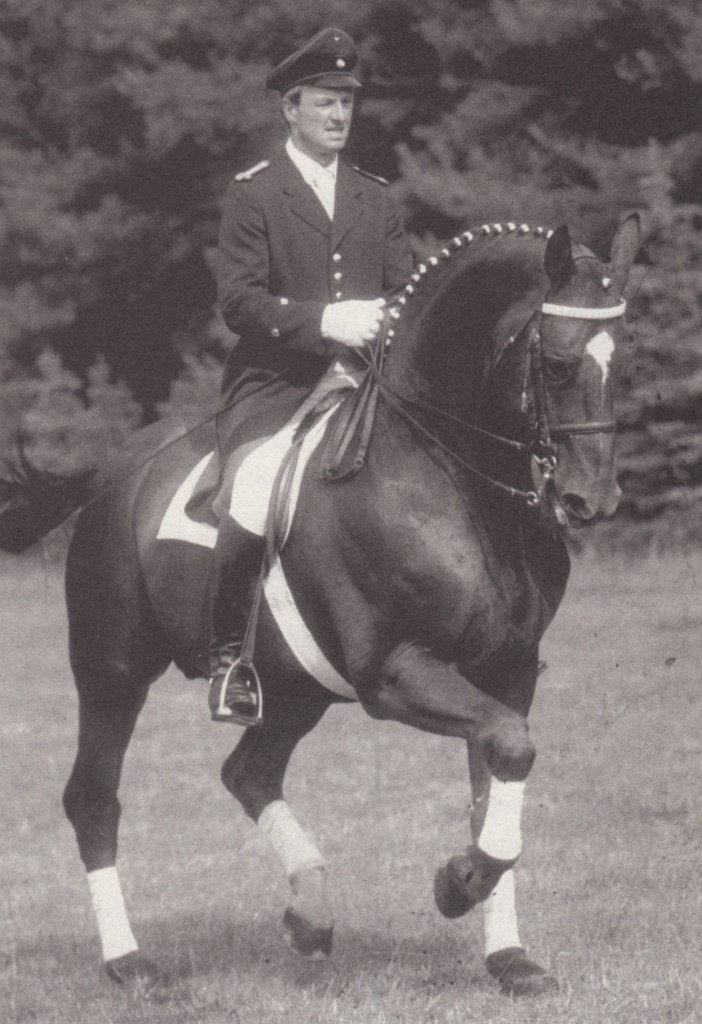
World Cup
First let’s de-code the alphabet soup, and see how F became W. The F-line goes back to Zemeboq, a Thoroughbred son who came from Pomerania and stood in the mid 1800’s. The line really began with his great-grandson Flingarth. who stood in the Verden area from 1909 to 1912, producing about 14 licensed sons. His best son was Fling, (1913-22), and all existing F-line horses go back to Fling.
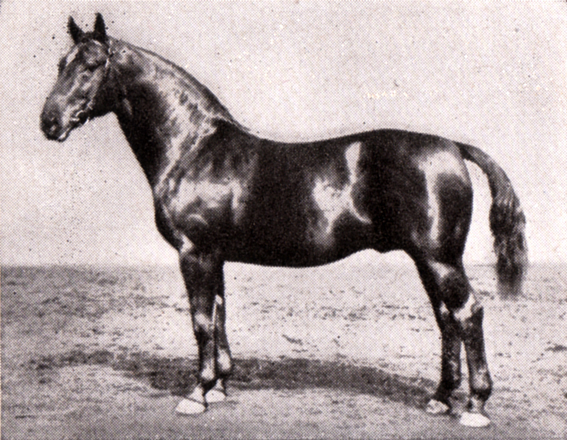
Fiener Kerl
The line was separated into the F and W lines according to the two Fling sons Fiener Kerl and Flavius. As of 1989, all stallions licensed in that year and going back to Feiner Kerl belong to the F-line; all going back to Flavius form the W-line.
It was Woermann’s son, World Cup I, the first of six full brothers, who filtered the blood and athletic ability of his sire through to more rideable dressage candidates.
Again, Ludwig Christmann sums up:
“Woermann had the super sons, Wenzel, World Cup. He produced very modern conformation, good types, good legs also and good gaits. World Cup also had super gaits, but maybe that was a time when Grand Prix was not so popular. During the last thirty years the number of Grand Prix classes has increased a lot, so World Cup really didn’t have such an opportunity to produce super Grand Prix horses.”
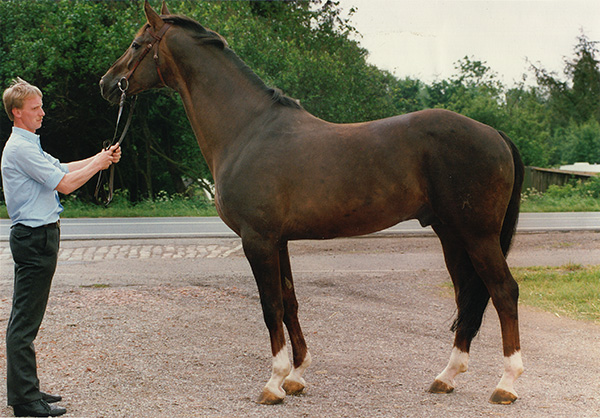
Wenzel, a super Woemann son
World Cup sired Weltmeyer in 1984, ushering in a decade of ‘W’ cult hysteria in Lower Saxony. We have seen how important Thoroughbred blood was in making the transition from Fling to Woermann, with Weltmeyer we introduce a new thread, the influence of the Trakehners who fled their homes in the face of the Russian Army and who long-time Celle Stud director, Dr Burchard Bade said, were the most important development in the post War years… In 1949, thirty-nine, Trakehnen stallions from eastern Prussia arrived in Celle.
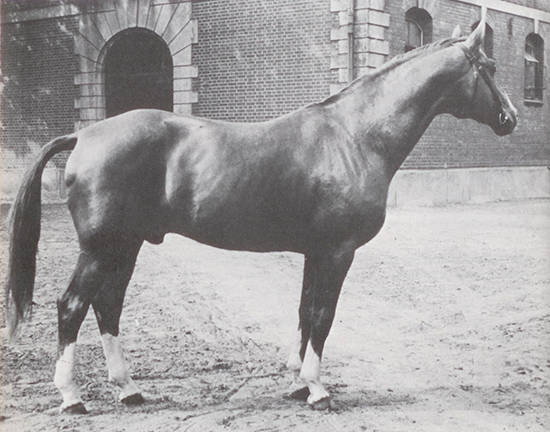
Abglanz
The most influential of the 39 was Abglanz (Termit / Poseidon) especially through his son Absatz, out of a Landmoor mare. Absatz was sire of Weltmeyer’s dam, Anka.
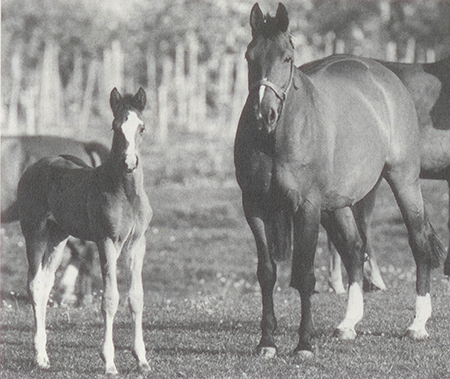
Anka
Weltmeyer was a sensation the day he was born, according to his breeder, Hermann Meyer, and he proved Mr Meyer right when he was champion of his licensing in Verden.
Incidentally, it is from Mr Meyer that Weltmeyer gets his name – ‘Meyer’ which is about as common in Germany as ‘Smith’ in England, and means something like ‘dairyman’.
As the Hanoverian heavies were celebrating Weltmeyer’s win at the licensing with a few hefty glasses of schnapps, they were contemplating an appropriate name, what about World Champion? Great, till someone remembered it had been taken, ah they said, the schnapps cutting in now, we’ll call him Weltmeyer – so Worlddairyman it was… I guess the story is funnier in German, with the schnapps.
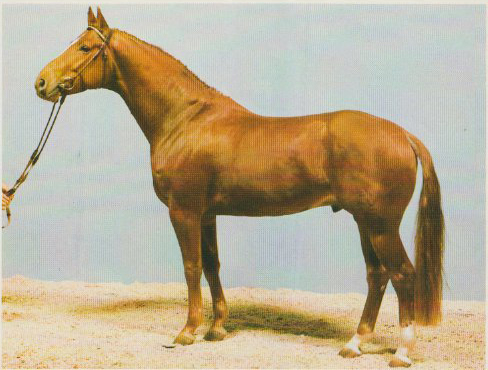
At the Bundeschampionate, Weltmeyer continued his triumphal progress. According to the then deputy breeding director of the Hannoverian Verband, Dr Ludwig Christmann: “He moved through the arena unflustered. His trot was magnificent. It could not have been any better. The judging committee gave him the top score of 10. His canter stride was a leap forward, flowing through the entire body of the horse. It earned a 9.5. The walk was ground-covering and earned an 8.0 (if there was a little worry about the Weltmeyer progeny it was in the area of the walk). In addition he received a 9.5 for conformation and for his overall impression.”
One of the few ‘doubters’ at the time was Westfalien born, bred and based, Johann Hinnemann who as the test rider for the ride-off at the Bundeschampionate, awarded Weltmeyer a score so low that the announcer declined to read it out, suggesting that the rider could reveal his score – and the reasoning behind it.
Years later, with Weltmeyer an acknowledged champion sire, Jo told me he was unrepentant:
“I have still not changed my mind. The director of the Hanoverian Stud, Dr Bade was very angry when we gave Weltmeyer low marks after riding him but we had to judge a riding horse competition and not a stallion competition. Weltmeyer is a monument of a horse, and he will produce – especially I think in the second generation – very good riding horses, which will bring breeding a step forward. But when I rode him at the Bundeschampionate in my opinion, he was a horse that was uncomfortable to ride, He had a 15 walk, a 15 trot and a canter for 15, you couldn’t handle that. He gave a lot of energy and perfect basic gaits to his offspring, and they were very successful at the Bundeschampionate, and now I have some horses here that have Weltmeyer as a grandfather and I am enthusiastic about that.”
Weltmeyer went on the win his performance test at Adelheidsdorf with a dressage score of 143.94 – more surprisingly he had a jumping score of 141.44, although I understand this result can be ‘managed’, the score is relative to the scores of other stallions in the test, and if you load the candidates with some very ordinary jumpers, you can inflate the score of the one you are promoting.
With the huge demand from mare owners for Weltmeyer, state stud director, Dr Bade took the unprecedented step of not sending Weltmeyer out to a stallion station, but keeping him at the breeding station in Celle where he was bred to 200 main studbook and State Premium mares from all over the Hannoverian breeding district. This was a ‘kick start’ the like of which no other first season stallion had received, and there are still those who question Weltmeyer’s success, claiming that it comes in no small part from the superior mares he covered.
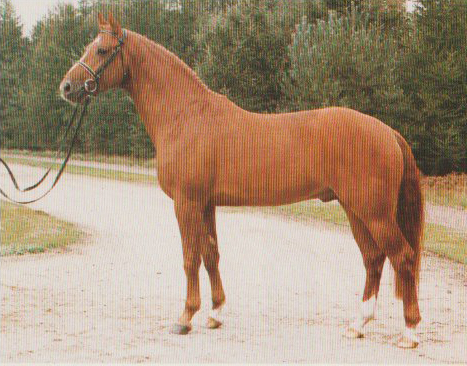
Fom his first crop, Wittinger (out of a mare by Raphael) was champion of his licensing, and went on the following year – like his dad – to win the title at the Bundeschampionate, and his performance test.
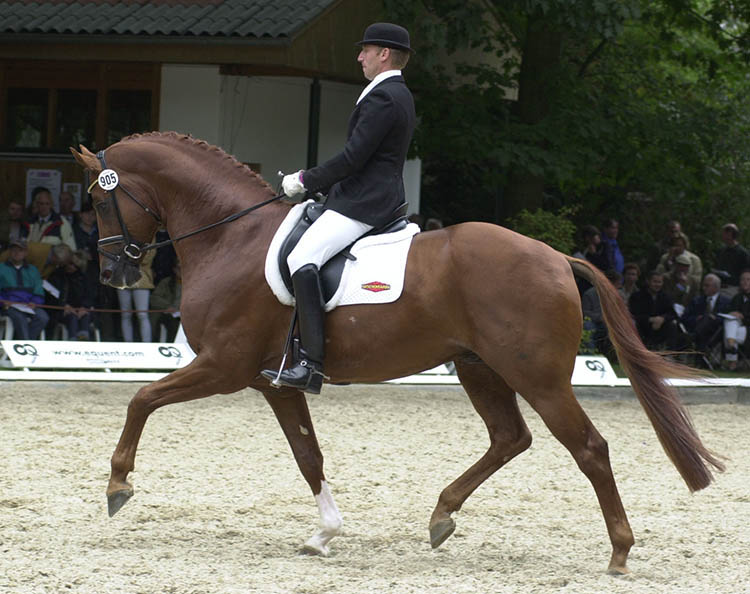
From the third drop,Wolkentanz won his licensing and he too went on to win at the Bundeschampionate, and stand reserve champion at his performance test.
In 1997 Weltmeyer’s first grandsons made their appearance with Welser (by Wolkenstein II, mare by Lanthan) reserve champion at the licensing, while the following year, Waterford (again by Wolkenstein II, mare by Matcho AA) won his licensing and Welser placed second in the performance test.
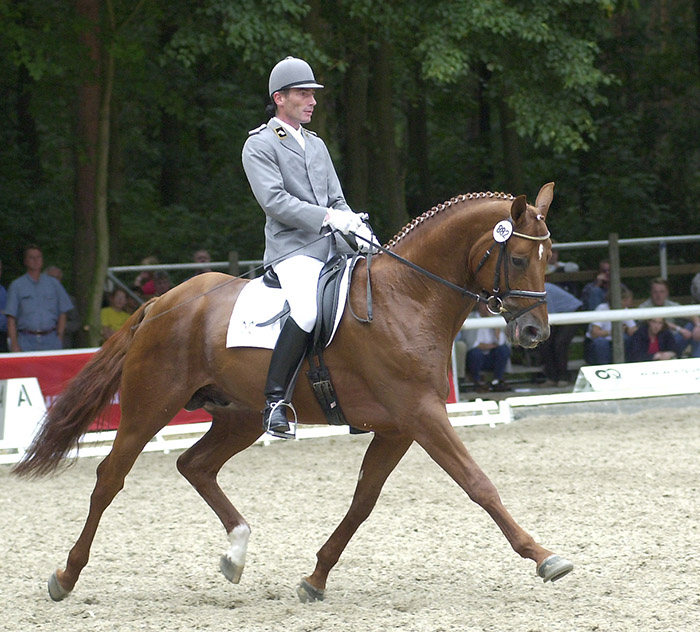
Waterford
In 1997 Weltmeyer’s first grandsons made their appearance with Welser (by Wolkenstein II, mare by Lanthan) reserve champion at the licensing, while the following year, Waterford (again by Wolkenstein II, mare by Matcho AA) won his licensing and Welser placed second in the performance test.
In the years that followed one after another licensing champion was sired by Weltmeyer and his sons, and before too long, the sons of sons were similarly crowned, but slowly the painful truth dawned, he was not producing dressage horses for top competition, a failure made glaringly obvious by the career of Donnerhall who was doing just that…
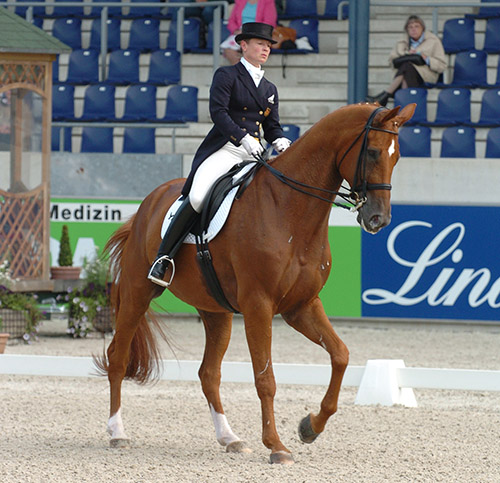
Warum Nicht
In the 2021 Hanoverian stallion book, Weltmeyer is credited with 1693 competitors with winnings of €2,750,210. Of these 213 competed at S level, with six going on to compete at four-star Grand Prix. He is the sire of 24 horses that have earned more than €24,000 in dressage competition, but really with just two international frontliners, Weltall (Picard) and Warum Nicht (Wenzel).
While today it is hard to find anyone with a good word for Weltmeyer, Hanoverian breeder and stallion keeper, Ingo Pape, is one who keeps his own counsel and is prepared to swim against the tide. I asked him why he thought Weltmeyer had failed to establish a stallion line.
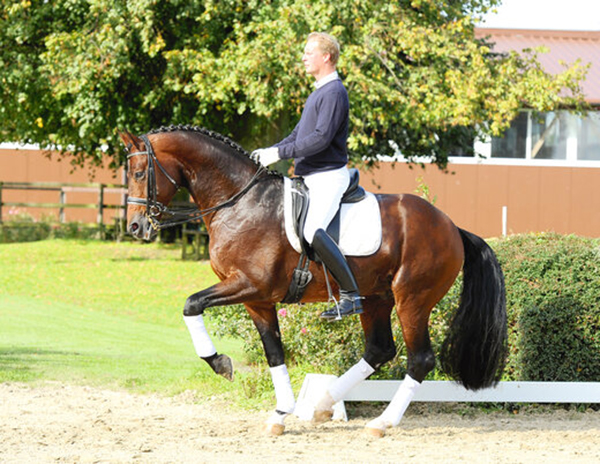
Scolari and Ingo Pape, the stallion is by Sandro Hit out of a De Niro / Weltmeyer mare
“It’s funny that some high ranked stallions produced sons, and other stallions are important through the mare lines. I really like to have Weltmeyer on the mother line, because you have strong top lines, and quick hind legs. I don’t know how many approved sons of Weltmeyer, there were (actually 86) – a lot, but very few that have been influential. But there are others, like the D line, or the Sandro Hit line where they have many sons, grandsons and great grandsons, that are influential, it goes on and on. But it is the same, for example, with Rubinstein. He was so influential for a decade, but the sons, aside from maybe Rubin Royal, there is nothing, no stallion sons.”
“It is different with Donnerhall and Sandro Hit, don’t ask me why it is like it is.”
Given that we have recently witnessed a revival of the B line, is a W re-evaluation in the wings? It is true that a number of the more fashionable sires of the moment are noticeably weak behind, perhaps other breeders will join Ingo Pape in looking for mares with Weltmeyer blood, since the chestnut stallion certainly produced horses with quick, strong hind legs.
Breeding a dressage star in Australia in 2023? There’s a great range available from www.ihb.com.au
Fynch Hatton, a new sire carrying Weltmeyer lines
